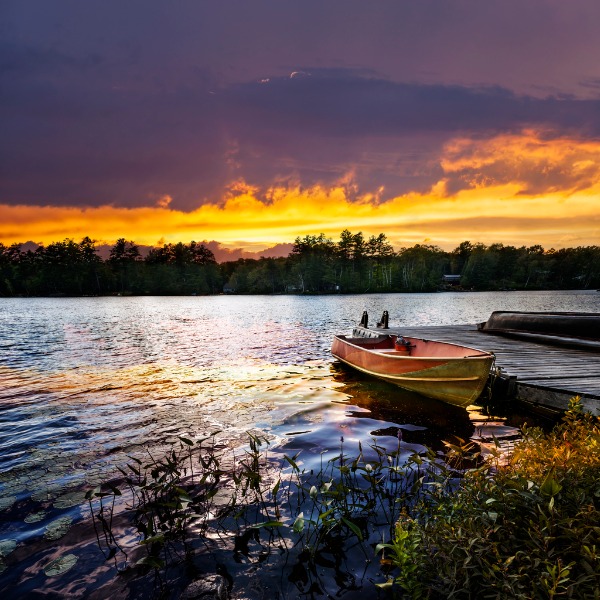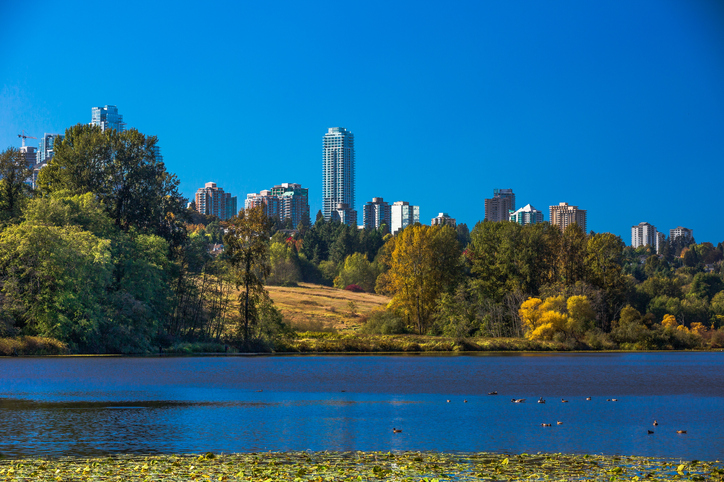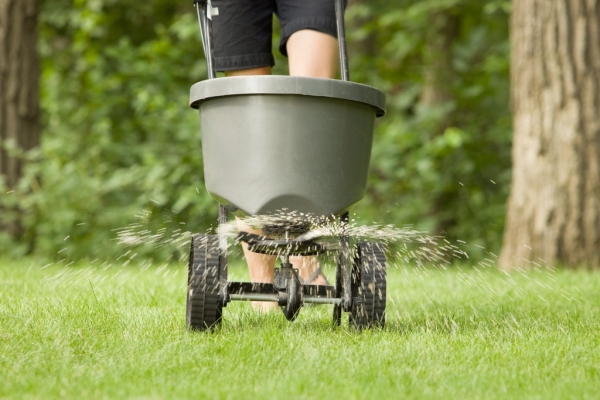Humans and Freshwater Ecosystems

Boat on a lake at sunset (Elenathewise, iStockphoto)

Boat on a lake at sunset (Elenathewise, iStockphoto)
How does this align with my curriculum?
Learn about how people impact the ecosystems of lakes and rivers.
Freshwater Ecosystems in Canada
Freshwater ecosystems play an important role in Canada.
Rivers, Lakes and Ponds
In the past, people used rivers and lakes for travel. They also used them to trade furs, harvest fish and transport logs. Rivers are still an important way to move things to international markets. They are also a source of hydroelectricity.
Image - Text Version
Shown is a historic print of people in canoes next to a large waterfall.
The paper is yellow and stained with age, but the image is still vibrant. It shows 11 people from the early 20th century at the left edge of a wide river. Some are getting out of a canoe still in the water. Others are unloading packs covered in canvas. Two in the background are carrying another canoe over their heads. Three more are carrying packs up a steep hill in the distance. On the right, the water above the falls is white and wild. It races over the edge and crashes into the calmer water below.
Lakes and ponds can also help to reduce flooding in towns and cities. A flood is when excess water covers land that is usually dry. Flooding can be a problem in places where there are a lot of roads and buildings. This is because water can’t pass through these things. It goes over or around them instead.
Rivers and ponds can also bring wildlife into urban places that don’t have many parks or green spaces. Scientists have proven that being close to nature can improve your well-being.
Image - Text Version
Shown is a colour photograph of a bright blue lake in front of a green park with skyscrapers on the horizon.
The water along the lower edge of the image is filled with green plants. Above, the clear water is bright blue with a little wind ruffling it. A few ducks float on the surface. The far shore is a gently sloping hill with gold grasses and large deciduous trees in shades of green and yellow. Beyond the park, a dense area of skyscrapers can be seen above the treetops. The sky above is clear and bright blue.
Plants living in bodies of water can collect carbon from the atmosphere. The term for this process is carbon sequestration. Plants take in carbon dioxide from the air. Then they use it to make the sugars they need for energy in a process called photosynthesis. When the plants die, they sink to the bottom of the water. This stores away the carbon they absorbed. Carbon sequestration is how ponds reduce greenhouse gases that contribute to climate change.
Many people use lakes and rivers for boating, swimming and fishing. Tourists come from around the world to enjoy them as well.
Wetlands
In the past, people often thought wetlands were useless land. People caused many direct impacts on wetlands. These include dredging wetlands to create harbours for ships and draining wetlands to build farms and cities.
Humans have also caused indirect impacts on wetlands. They have introduced invasive species. These are plants and animals that are not native to the area. Invasive species can outcompete native species for food and habitat. This sudden change can have a negative effect. It can harm other species in the food web and the wetland ecosystem.
Scientists now have a better understanding of wetlands. They know they are important water reserves. Most of the water we use every day comes from water stored underneath wetlands. They know wetlands also act as filters. They remove suspended particles, fertilizers and toxic pollutants from the water. They know that wetlands can act like giant sponges during floods, absorbing extra water. Finally, wetlands are a unique ecosystem. They supply food and spawning areas for many types of animals.
Freshwater Ecosystems and Water Quality
Water quality is the chemical content, physical characteristics and biological nature of water. It can include many measurements. Temperature is one. Concentration of substances, like dissolved oxygen or heavy metals, is another. And the number and kinds of microorganisms is another. Water quality can change for many reasons. Some changes are natural. Human activities cause others.
Water from rain and melted snow runs across the land towards lakes and rivers. The term for this water is surface runoff.
Surface runoff is a major source of water pollution. It can pick up many things along the way. Runoff in cities and towns picks up litter and organic matter from the streets. It can also pick up things like salt, sand, gasoline and motor oil and carry them into storm drains. And all these materials end up in aquatic ecosystems.
Image - Text Version
Shown is a colour photograph of a sewer grate with mud, leaves, flowers and garbage caught in the metal bars.
The camera looks down at the rectangular grate, which is set into dark grey concrete. On the right, the spaces between the bars of the metal grid are blocked with a thick brown substance. At the edge of this are crushed leaves, flowers, grass and bits of garbage. Below the grate, a dark, wet area is just visible.
Surface runoff can also contain things like pesticides. People use these chemicals on lawns, gardens and golf courses to kill unwanted plants and animals. These chemicals are as harmful in water as they are on land.
Fertilizers have nutrients that plants need. These include phosphates and nitrates. But when fertilizers get into a body of water, they can cause algae there to grow quickly. When these algae die, microorganisms break them down. Microorganisms use oxygen to do this. This means there is less oxygen in the water. Low oxygen levels can cause fish and invertebrates to die. This term for this process is eutrophication.
Laundry detergents often contain phosphates. These make detergents work better, but they can get washed into aquatic ecosystems. This also causes eutrophication.
Image - Text Version
Shown is a colour photograph of a person pushing a bucket on wheels that is spreading white granules of fertilizer on to grass.
The camera is focused on a large green bucket with a long handle. The granules spill out from the bottom of the bucket, where they are spread by a black wheel, in a wide circle. The whole structure rolls on four small, black rubber wheels. The grass below is green and neat. A person’s legs can just be seen pushing the bucket from behind.
Farming, mining and industrial activities also affect water quality.
Farming
Runoff from farmland can contain pesticides, fertilizers and animal waste. It can also have small rock particles. These are from the erosion of soil in farm fields. Animal waste can contain fecal coliforms. This is a group of bacteria and other harmful microorganisms.
Mining
There are four main ways mining affects water quality.
- Acid Mine Drainage. This happens when water and oxygen react with rocks that contain sulphide-bearing minerals. This produces sulphuric acid. Surface runoff moves this acidic water from mines into rivers and lakes. This can change the acidity, or pH, of the water.
- Heavy Metal Pollution. This happens when mined rock containing metals comes into contact with water. These metals could include arsenic, cobalt, copper, cadmium, lead, silver and zinc. Surface runoff can carry these metals into bodies of water.
- Processing Chemicals Pollution. This happens when the chemicals used to separate minerals from ore in the mine, spill or leak into nearby bodies of water. These chemicals can be toxic to people and wildlife.
- Erosion and Deposition. Mining can cause the erosion of large amounts of rock and soil. These eroded materials can clog rivers and streams and harm vegetation, habitats and organisms.
Image - Text Version
Shown is a colour aerial photograph of a large, bright green pond with roads and pits around it, next to a deep blue river.
The pond is almost triangular and bright, mint green. Some of the land around it is forested, but many trees have been removed, revealing dry beige soil and roads. Large machinery can be seen in one of the bare areas. Just above is a wide, curved, deep blue river. This is dotted with small forested islands. The land on the far shore is also thick with coniferous trees. A second pond is just visible in the distance. It is surrounded by forest, and also deep blue in colour.
Industrial Activities
Industrial waste is waste made by manufacturing and other industries. It includes things like garbage, scrap metal, gravel, grass clippings and chemicals. Industrial waste can be solid or liquid. Liquid waste like cleaning fluids, paints, dyes and solvents contributes to water pollution. Sometimes this waste is pumped into lakes and rivers. Sometimes it leaks out of storage containers. Industrial waste can harm aquatic ecosystems. It can make water unusable, now or in the future.
Conservation
Many living things depend on freshwater ecosystems. Many people recognize the value of lakes, rivers and wetlands. Governments are writing laws and regulations to protect freshwater ecosystems. People are also making efforts to restore and preserve these ecosystems.
Conservation includes rehabilitating or restoring areas to health. It also includes purchasing or securing land with important habitats. Rehabilitation can include re-establishing natural water levels. It can also include controlling invasive species and removing contaminated sediments.
Here are some things you may be able to do to keep these ecosystems healthy. These steps will help improve water quality and the environment.
- Don’t rinse bits of food down the drain. Compost them instead.
- Don’t flush garbage down the toilet. Put it in the garbage can.
- Use cleaning products that are low in phosphorus. These can cause less eutrophication.
- Don’t use chemical herbicides or pesticides. Pick weeds by hand.
- Don’t pour paints or chemicals down the drain. Bring them to a liquid waste collection centre.
- If you’re out on a boat, don’t throw garbage overboard. Keep it until you get to shore and dispose of it properly.
Many organizations are working to conserve Canada’s aquatic ecosystems. One way you could help is through a local shoreline clean up. Or you could contact local environmental groups for other ideas.
Learn More
How does clothing impact water systems?
This backgrounder from Let’s Talk Science explains how clothing manufacturing and washing contribute to water pollution.
What Is Eutrophication? (2012)
This video (1:54 min.) from FuseSchool illustrates what happens above and below water during the process of eutrophication.
Reclaiming B.C.'s waterways from mining pollution (2023)
This video (2:03 min.) from CBC News shows how Indigenous communities in Canada and the United States are working to rehabilitate the Kootenay River from mining pollution.
Managing Stormwater Runoff (2019)
This video (2:04 min.) from MetroVancouver illustrates the process of surface runoff pollution, and what you can do to prevent it.
References
Earth Networks. (n. d.). Flood Causes and Effects.
Government of Canada. (2020, January 24). Agriculture and water quality. Canada.ca
Ontario Ministry of Natural Resources and Forestry. (2017). A wetland conservation strategy for Ontario 2017-2030. Ontario.ca
Oram, B. (n. d.). Water Testing Fecal Bacteria Pathogenic Organisms Water. Water Research Center.
Paquette, C. Water pollution in Canada and what you need to know. (25 March 2016). WWF.ca
Safe Drinking Water Foundation. (n. d.). Industrial Waste.
Safe Drinking Water Foundation. (n. d.) Mining and Water Pollution.
USGS. (n. d.). Mining and Water Quality.
World Wildlife Fund. (n. d.) Canada’s Watershed Report. Watershedreports.wwf.ca




